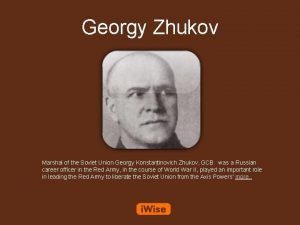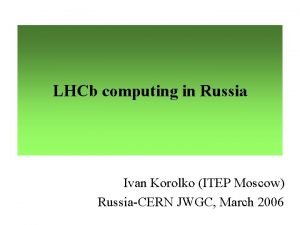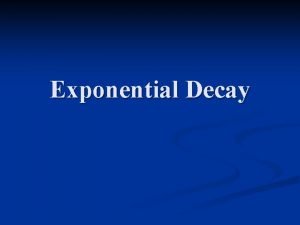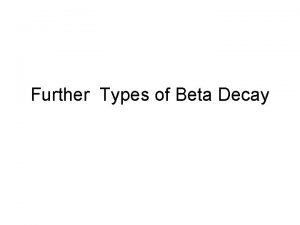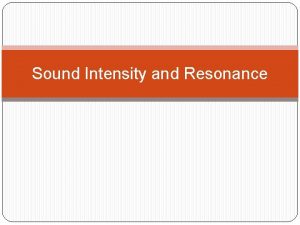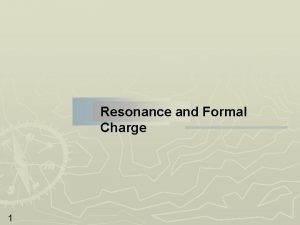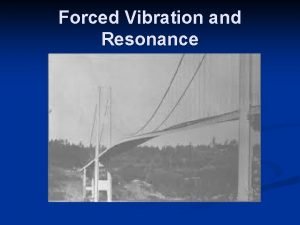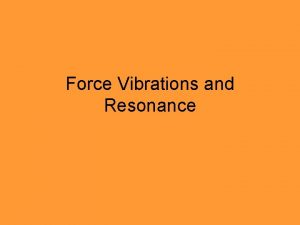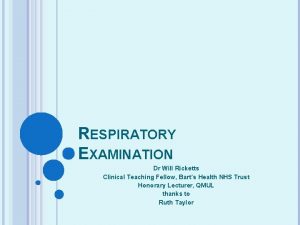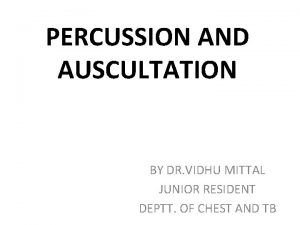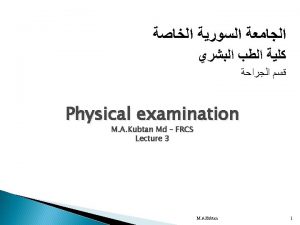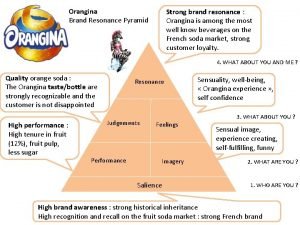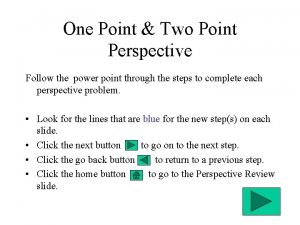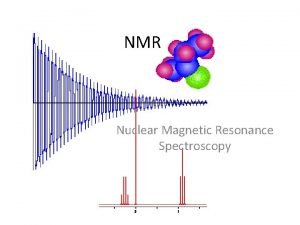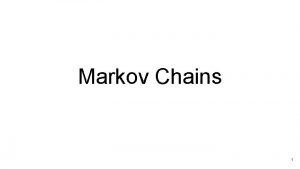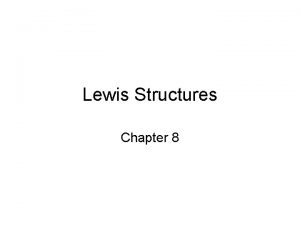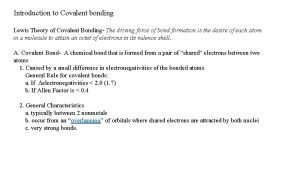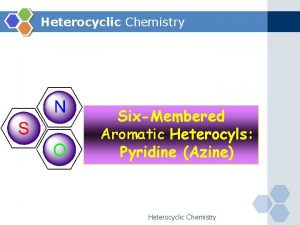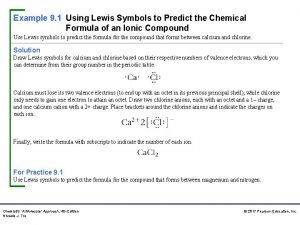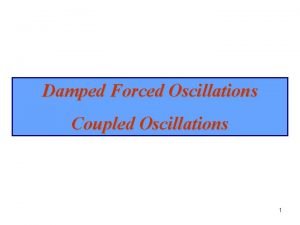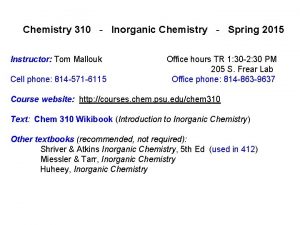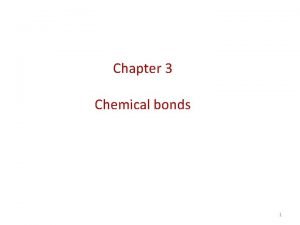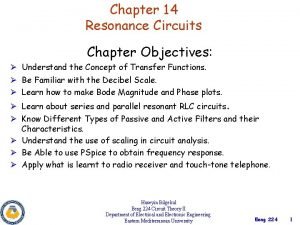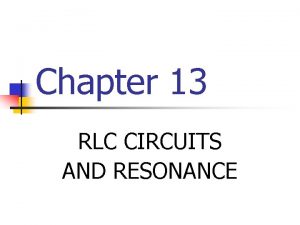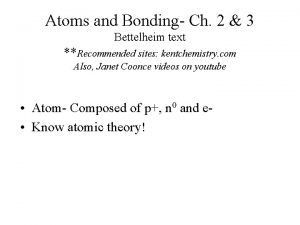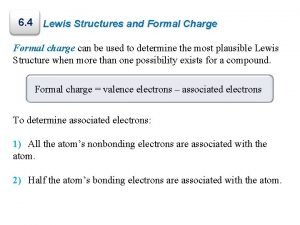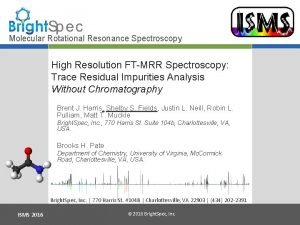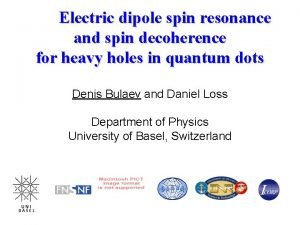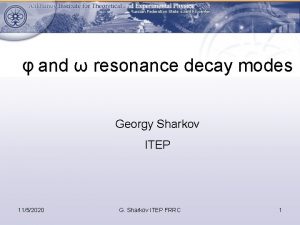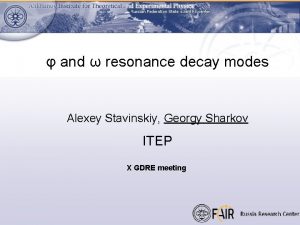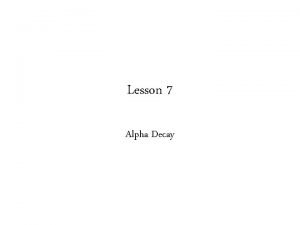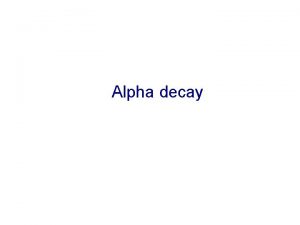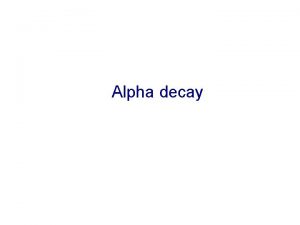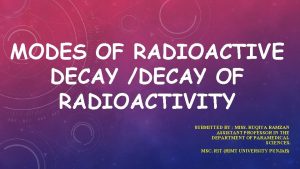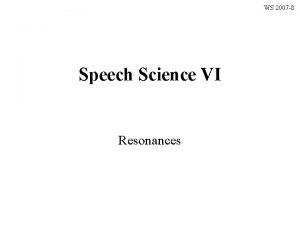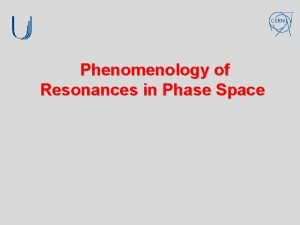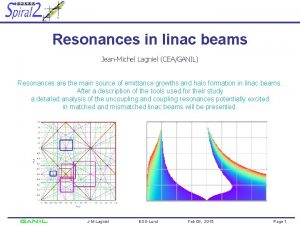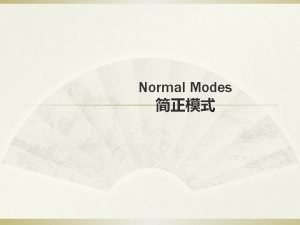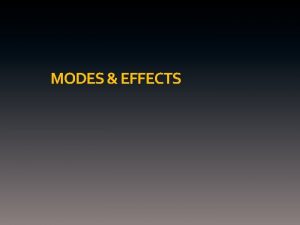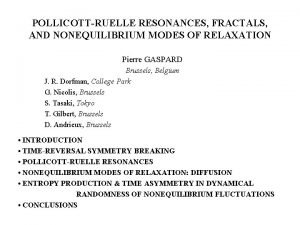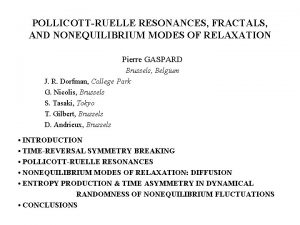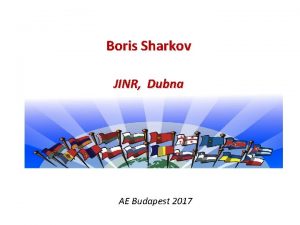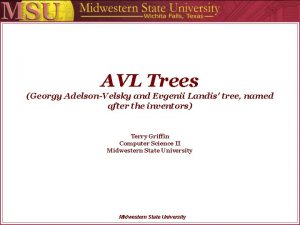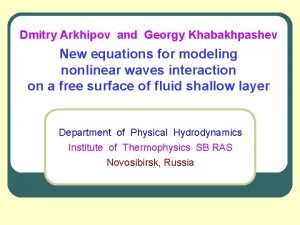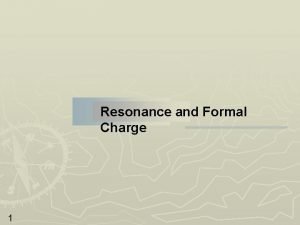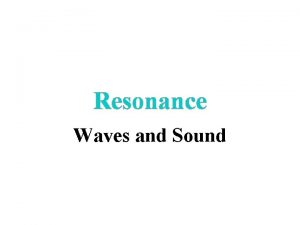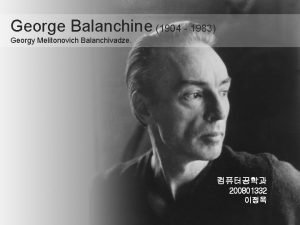and resonance decay modes Georgy Sharkov ITEP resonances






















![Direct photons analysis ω a 1(1260) η' Re: [URQMD] ftn 15 (fwd) K* f Direct photons analysis ω a 1(1260) η' Re: [URQMD] ftn 15 (fwd) K* f](https://slidetodoc.com/presentation_image_h2/e9cb48d80580779cdd61ac3676fb3b1f/image-23.jpg)











- Slides: 34

φ and ω resonance decay modes Georgy Sharkov ITEP

, ω resonances If resonance decays before kinetic freeze-out Possible rescattering of hadronic daughters Reconstruction probability decrease for hadronic mode A. V. Stavinsky, Acta Phys. Polon B 40; 1179 -1184, 2009 ω(782) π+ π- π0 B. R. 0. 89 ω(782) π+ π- B. R. 0. 017 ω(782) π0 B. R. 0. 089 ω(782) e+e- B. R. 0. 000072 φ(1020) K+ K- B. R. 0. 49 φ(1020) η B. R. 0. 013 φ(1020) e+e- B. R. 0. 000297 χc 0 (c = 23 fm) (c = 44 fm) (c = 37 fm)

t hadrons with &without QGP quarks&gluons

Model l 0~cτβ/√(1 -β 2) ~ ~(β=1/3 for this estimate)~ ~15 fm(for φ) & 8 fm(for ω) l 0 φ li η η li~2 fm for any hadron & 1 fm for any pair of hadrons l hadronization 10/25/2021 G. Sharkov ITEP FRRC Kinetic freeze-out 4

Model • Upper line – lepton mode Splitting – two hadron and hadron-photon modes l -decay products trajectory length within matter φ β= 1/3 ω l, fm 10/25/2021 G. Sharkov ITEP FRRC 5

Is it really possible measurement? • Existing data from PHENIX& STAR – Bφ/ e+e– Bφ K+K– B p+p-p 0, p 0 – Bφ η ? 10/25/2021 G. Sharkov ITEP FRRC 6

Φ(1020) K+ KΦ(1020) e+e- B. R. 0. 49 c = 44 fm B. R. 0. 000296 c = 44 fm d+Au PHENIX Φ K+ KSTAR Preliminary √s. NN = 200 Ge. V Au+Au 10/25/2021 Φ e+e- PHENIX √s. NN = 200 Ge. V 7

ω(782) π+ π- π0 B. R. 0. 89 c = 23 fm ω(782) π0 B. R. 0. 089 c = 23 fm PHENIX η, ω π+ π- π0 η(547) π+ π- π0 B. R. 0. 23 c = 167225 fm p+p Au+Au p+p ω π0 PHENIX ω π0 10/25/2021 √s. NN = 200 Ge. V PHENIX G. Sharkov ITEP FRRC 8

Y. Nakamiya Hiroshima University, Japan for the PHENIX collaboration QM 2008, India Branching ratio between e+eand K+K- may be sensitive to mass modification, since Mphi is approximately 2 MK. -> Compare yields of e+eand K+K- 10/25/2021 G. Sharkov ITEP FRRC 9

Φ Production K+K- and e+e- e+ e- K+ K- • The leptonic channel yield is a little higher than hadronic channel • More accurate measurement is required to confirm whethere is branch ratio modification 10/25/2021 G. Sharkov ITEP FRRC 10

To Do • To make calculations for the effect of interest within realistic model • To create algorithm for photonic modes identification in AA interactions • To check this algorithm for CBM conditions with realistic simulations 10/25/2021 G. Sharkov ITEP FRRC 11

Model requirements • realistic representation of particles (γ!) • evolution in time – distinguish particles produced in dense and rare phases EPOS • Energy conserving quantum mechanical multiple scattering approach, based on • Partons (parton ladders) • Off-shell remnants, and • Splitting of parton ladders. 10/25/2021 G. Sharkov ITEP FRRC 12

+ (elastic scattering) Statistical Hadronization Models P. Braun-Munzinger, I. Heppe, J. Stachel, Phys. Lett B 465 (1999) 15; F. Becattini, J. Manninen , M. Gazdzicki, Phys. Rev. C 73 (2006) 044905, hep-ph/0511092; J. Cleymans, H. Oeschler, K. Redlich, S. Wheaton, Phys. Rev. C 73 (2006) 034905, hep-ph/0511094; J. Rafelski, M. Danos, Phys. Lett. 97 B (1980) 279; J. Rafelski, J. Letessier, J. Phys. G: Nucl. Part. Phys. 28 (2002) 1819 and blast-wave fits E. Schnedermann, J. Sollfrank, U. Heinz, Phys. Rev. C 48 (1993) 2462 [8] F. Retiere, J. Phys. G 30 (2004) S 827 -S 834, nucl-ex/0405024; J. Adams, STAR Collaboration, Phys. Rev. Lett. 92 (2004) 112301; I. Kraus, NA 49 Collaboration, J. Phys. G 31 (2005) S 147 -S 154 10/25/2021 G. Sharkov ITEP FRRC 13

EPOS √s=200 Ge. V d. Au K. Werner Nucl. Phys. B 175 (2008) 81 Au+Au @ 200 Ge. V (RHIC) 10/25/2021 Klaus WERNER, Phys. Rev. Lett. 98, 152301 (2007), ar. Xiv: 0704. 1270. G. Sharkov ITEP FRRC Pb+Pb @ 17. 3 Ge. V (SPS) 14

EPOS & Ur. QMD 10/25/2021 G. Sharkov ITEP FRRC + π 15

• • Generate EPOS statistics Check all decay modes Tune EPOS output for CBMROOT Produce CBMROOT events with full ECAL 10/25/2021 G. Sharkov ITEP FRRC 16

10/25/2021 G. Sharkov ITEP FRRC 17

10/25/2021 G. Sharkov ITEP FRRC 18

Ur. QMD EPOS 10/25/2021 G. Sharkov ITEP FRRC 19

10/25/2021 G. Sharkov ITEP FRRC 20

10/25/2021 G. Sharkov ITEP FRRC 21

Extra slides 10/25/2021 G. Sharkov ITEP FRRC 22
![Direct photons analysis ω a 11260 η Re URQMD ftn 15 fwd K f Direct photons analysis ω a 1(1260) η' Re: [URQMD] ftn 15 (fwd) K* f](https://slidetodoc.com/presentation_image_h2/e9cb48d80580779cdd61ac3676fb3b1f/image-23.jpg)
Direct photons analysis ω a 1(1260) η' Re: [URQMD] ftn 15 (fwd) K* f 1(1285) • Only from decay Ur. QMD code • 2 γγ elastic scatterings(? !) 2006 Ur. QMD generator & cumulativeprocesses "hm, yes photons are mesons in urqmd. however, photons should not be calculated within the urqmd, but explicitely outside with a different code. everybody should ignore all processes with photons involved. we will move them out of the model in the next version. cheers, Marcus Bleicher" CBM simulation

Formulas 10/25/2021 G. Sharkov ITEP FRRC 24 Stavinskiy, ITEP, 10. 06. 08

Electron, hadron and photon in PHENIX / e+e- e+ • PHENIX acceptance -0. 35 < η < 0. 35 2 x 90°in azimuthal angle for two arms • Event selection BBC e- , • Electron ID RICH EMCal Momentum Electron ID K + K- • photon ID EMCal p+p-p 0, p 0 • Hadron ID TOF EMCal-TOF Energy K+ 10/25/2021 Momentum Hadron ID K- p 0 p+ p G. Sharkov ITEP FRRC Momentum Hadron ID 25

Extended Consistency between K+K- analysis K+K- and e+e. Double ID analysis K+ K- candidates d+Au no ID analysis h+ candidates Single ID analysis K+ or K- 0 -20% h- h+ or h- candidates No No ID ID Single ID ID Double ID ID e+ e- M. B. p+p • K+K- measurements have been extended to both higher and lower new methods, no kaon and single kaon ID methods. - and T using Inpp+p, spectra of e+ei. e. K+K-IDshow reasonable agreement! 10/25/2021 G. analyses Sharkov ITEP are FRRCconsistent with each other. 26 • The three independent kaon

Spectra comparison between e+e- and K+K- Au+Au e+e- Au. Au MB e+e- 20 -40% x 10 -3 e+e- 40 -92% x 10 -1 K+K- Au. Au MB (no PID) K+K- Au. Au MB (double PID) K+K- Au. Au MB (PRC 72 014903) K+K- 20 -40% x 10 -3 (double PID) K+K- 40 -92% x 10 -1 (PRC 72 014903) M. B. 20 -40% 40 -92% Errors are too large to make any. ITEP clear 10/25/2021 G. Sharkov FRRC statement about the comparison of spectra for e+e- and K+K-. 27

Yield comparison between e+e- and K+KQuestion 1’: Have we observed changes of yield between e+e- and K+K- ? Comparison of integrated yield is not enough, because mass modification effects depend on the p. T region. Low p. T mesons tend to decay inside the hot/dense matter Low p. T High p. T In addition, To determine the integrated yield, an extrapolation to lower p. T is needed. There is a large uncertainty in the calculation. Thus, p. T-dependent information is essential for comparison. Now, we should ask 10/25/2021 G. Sharkov ITEP FRRC Have we observed changes of spectra between e+e- and K+K 28 - ?

What is the difference? • Modes absorbtion vs Mass modification – Standard mesons vs modified mesons – φ→KK & φ→η • Modes absorbtion vs K/K* ratio – Lepton modes vs thermal model – Hadron stage vs equilibrium stage • Modes absorbtion vs both other approaches – Internal cross-check - 3 modes 10/25/2021 G. Sharkov ITEP FRRC 29 Stavinskiy, ITEP, 10. 06. 08

Real σMN in matter can differ from that in free space • ω photoproducton on nuclear targets (ELSA) M. Kotulla et al. , Ar. Xiv: nucl-ex/08020980 σωN ≈ 70 mb (in nuclear medium, 0. 5 < P <1. 6 Ge. V/c) σωN ≈ 25 mb (in free space - the model calculations) photoproducton on nuclear targets • photoproducton on nuclear targets T. Ishikawa et al. , Phys. Lett. B 608, 215, (2005) σφN= 35 ± 14 mb (in nuclear medium) σφN ≈ 10 mb (in free space) “φ-puzzle” 10/25/2021 G. Sharkov ITEP FRRC 30

Measurements of w in wide p. T range p. T spectra of w are measured for several decay modes in d+Au and p+p. w p 0 d. Au MB (PRC 75 151902) w p 0 p+p- d. Au MB(PRC 75 151902) w e+e- pp MB (PHENIX preliminary) w p 0 pp MB (PRC 75 151902) w p 0 p+p- pp MB(PRC 75 151902) w p 0 pp ERT (PHENIX preliminary) w p 0 p+p- pp ERT (PHENIX preliminary) w d+Au p+p 10/25/2021 G. Sharkov ITEP FRRC 31 Spectra show good agreement among several decay channels.

Branching ratios as an instrument for density integral measurements mesons ( mesons) new source of information Interplay between different ALICE subdetectors(? ) Stavinskiy, ITEP, 9. 04. 08


Why ? (common part) The meson was proposed in the middle of 80’(Koch, Muller, Rafelski PR 142, Shor. PRL 54) as one of the most promising QGP messengers because of the following reasons: – an enhancement of –meson, as well as other strange hadrons in QGP phase – interaction cross section is small and will keep information about the early hot and dense phase – meson spectrum is not distorted by feeddown from resonance decays – strangeness local conservation for Stavinskiy, ITEP, 9. 04. 08
 Georgy zhukov
Georgy zhukov Itep moscow
Itep moscow How to find the decay factor from a table
How to find the decay factor from a table Beta decay equation
Beta decay equation Sound intensity and resonance
Sound intensity and resonance Formal charge nco-
Formal charge nco- Forced vibration and resonance
Forced vibration and resonance Resonance in open pipe
Resonance in open pipe Forced vibration and resonance
Forced vibration and resonance Brand judgement meaning
Brand judgement meaning Brand resonans
Brand resonans Electron delocalization and resonance
Electron delocalization and resonance Tar staining
Tar staining Boundaries of kronig isthmus
Boundaries of kronig isthmus Dullness to percussion
Dullness to percussion Ch2o lewis structure
Ch2o lewis structure Brand pyramid
Brand pyramid Two point perspective stairs
Two point perspective stairs Resonance in nmr
Resonance in nmr No arrows
No arrows Write the lewis dot structure of co molecule
Write the lewis dot structure of co molecule Ccl2o lewis structure
Ccl2o lewis structure Pyridine resonance
Pyridine resonance Ocn- resonance structures
Ocn- resonance structures Coupled pendulum
Coupled pendulum Ocn- resonance
Ocn- resonance Why do nonmetals rarely lose electrons
Why do nonmetals rarely lose electrons Series and parallel circuits
Series and parallel circuits Vc
Vc Brand resonance
Brand resonance Brand pyramid template
Brand pyramid template Binary compounds
Binary compounds How to calculate formal charge?
How to calculate formal charge? Molecular rotational resonance
Molecular rotational resonance Electric dipole spin resonance
Electric dipole spin resonance
